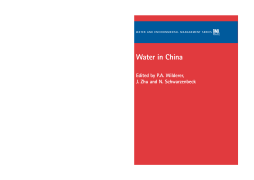
Additional Information
Book Details
Abstract
Rapid growth of cities and industries in China is having a dramatic impact on the environment. To counteract further decrease of water quality of rivers, lakes and groundwater bodies, an ambitious environmental remediation programme needs to be designed and brought into action. Intensive research and development activity are required to provide tailored solutions. The articles compiled in the book describe the current situation in China with respect to surface water quality and wastewater treatment, and provide results of specific research projects, leading the way to a China-specific up-to-date water treatment technology. Discussed are lessons to be learnt from the experience made in other countries, particularly with respect to regulations and management practices
Table of Contents
| Section Title | Page | Action | Price |
|---|---|---|---|
| Contents | 6 | ||
| Preface | ix | ||
| Water resources and ecological problems in Tarim River basin, Xinjiang, China | xiii | ||
| Determination of weighting coefficients in water quality index method and its application in river water quality evaluation | xxiii | ||
| Performance of a two-stage BAF system treating heavily polluted river water at low temperatures | xxxii | ||
| Legislation for drinking water in the EU and its member states | xl | ||
| Industrial water resource management and recycling experiences from Germany | xlix | ||
| Organic trace analysis by GC-ITD/MS and LC-ESI/MS/MS applied to MX and other disinfection by-products in water treatment | lxix | ||
| Application of FISH and CLSM / image analysis for microbial examination in biological wastewater treatment in China | lxxviii | ||
| An analysis of water situation and water consumption in several regions in China | lxxxix | ||
| Analysis and application of grey model and multiple linear regression in long-term water demand forecasting | xcviii | ||
| Phosphorus limitation in drinking water biological treatment and its application in removing organic matters | cvii | ||
| Effects of direct fiber filtration on algae removal | cxv | ||
| Investigation of micropolluted raw water treatment using enhanced coagulation technology | cxxiii | ||
| Enhanced filtration for pollutants removal | cxxxi | ||
| Soil infiltration and purification of stormwater runoff in Beijing urban area | cxlv | ||
| Flush model of runoff on urban non-point source pollutants and analysis | cliii | ||
| Coagulant behvior of different inorganic polyaluminium coagulants | clxiii | ||
| Nightsoil treatment for China: present and future perspectives | clxxxi | ||
| Disposal of domestic wastewater and sludge in rural regions via back to nature solutions | clxxxix | ||
| Decentralized wastewater treatment systems | cxcvii | ||
| Perspective of source control sanitation systems in China | ccvii | ||
| Experiences on full-scale anaerobic fluidized bed and upflow anaerobic sludge blanket reactors treating industrial wastewater | ccxiv | ||
| Rationally constructing small-scale wastewater treatment plant to raise the regional treatment ratio of wastewater | ccxxiii | ||
| Performance of a WWTP using submerged biofilm process with zero sludge discharge | ccxxxi | ||
| Experimental study on HMBR for wastewater reclamation in dwelling district | ccxl | ||
| An innovative process for the treatment of both wastewater and excess activated sludge | ccxlviii | ||
| Performance of a WWTP using a submerged biofilm process with zero sludge discharge | ccxxxi | ||
| A BPNN model of key ecological factors affecting sulfate-reduction | cclvii | ||
| Keyword Index | cclxv |
